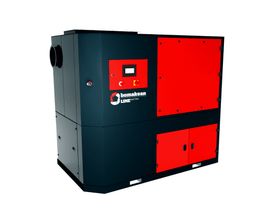
The most popular welding method nowadays is welding mild steel, which is important for any industry using welding in its production process. The latest scientific research has shown that the fumes produced by this method may be potentially carcinogenic. Although we have yet to see the full effects of this finding, it is clear that the health and safety of welders and the methods by which they can be ensured will increasingly be based on facts.
How is welding fume produced?
Welding fumes are created by heating a metal above its boiling point. The vapors created by this thermal process condense into fine particles, creating a cloud that hangs in the surrounding air. This suggests that the fume cloud, particles, and gases will penetrate the welder's breathing zone (<30 centimeters / 12 inches from nose and mouth), posing a serious risk for inhalation.
Although different welding methods produce different amounts of gases, they all contain varying concentrations of hazardous substances. The most popular and harmful of these are chromium, manganese, nickel, NOX, and CO. Because smaller particles seem to end up deeper in the lungs upon inhalation, they are considered the greatest health risk, along with the gases.
Welding fumes are carcinogenic to humans
In April 2017, new scientific evidence released by IARC, the International Agency for Research on Cancer, found that welding fumes from mild steel can cause human lung cancer (and possibly kidney cancer). The most direct legislative result of this was that the Health and Safety Executive (HSE), an organization dedicated to occupational safety, reclassified mild steel welding fume as a human carcinogen in the United Kingdom.
Since general ventilation does not meet the necessary emission control, the HSE has issued a change in compliance expectations, meaning all companies performing welding activities must implement effective engineering controls to prevent exposure to welding fumes. The HSE no longer tolerates welding without adequate exposure control measures, regardless of duration, as there is no established level of safe exposure. (Source: www.hse.gov.uk)
Different welding processes require alternative extraction solutions
The most effective method for capturing and removing fumes has been found to be source extraction (also known as local extraction ventilation, or LEV). The reasons why source extraction is the most effective are that it captures all fumes and gases before the operator breathes them in, and the energy consumption required by this method is the lowest. Interfilter supplies mobile welding fume extractors tailored to the type of steel being welded and the level of use.
However, it is not always feasible to use source extraction or LEV systems. In some applications, welders change welding positions very frequently. This mainly occurs when welding large parts. In such systems, alternative extraction systems may be useful, such as the ALVER model AIR TOWERS or PUSH-PULL extraction systems.

New generation of welders: Welding robots
With the rapid advancement of technology, robots continue to enter our lives day by day. In this time where technologies shaping the future, such as Industry 4.0, are beginning to take important places in our lives, it is inevitable that welding operations will also be automated and robots will be increasingly used.
Welding robots are now used in many industries. Welding robots, which have become widespread through their use in the automotive industry, are used in many production industries.
Of course, welding fumes and gases are also released as a result of welding robots. The main difference between the welding fumes created by the robot operator and the human operator is that the robot operators do not breathe. For this reason, when designing welding fume extraction and filtration systems, we no longer need to be concerned about capturing the fumes before the robot breathes. This concern is replaced by capturing and filtering the welding fume emitted from various points before it disperses into other parts of the production area.
It is likely that the health and safety requirements for welders will continue to improve.
While it is difficult to predict potential welding regulations, there are other predictions we can make about industrial welding itself. While different welding processes used to encompass many different segments in the past, a more versatile welding method is becoming much simpler nowadays. This includes complex movements and welding multiple parts at one point in the production, aided by customized source extraction or creating a component as a whole in a 3D printing process.
Why not just welding fume extraction, but also filtration?
You may think that removing welding fumes from the environment is sufficient to protect the health of welding operators and employees, and that filtration is not necessary. In that case, welding fumes from each welder can be extracted with a central fan and released into the atmosphere. However, this will increase costs for your company several times:
-
If the indoor air is heated, you will not get a chance to recover this heated air. However, with an effective filtration system, you can return all extracted air back into the indoor environment and achieve significant energy savings.
-
It is not possible to use mobile/portable systems without filtration. Otherwise, you will be transferring harmful vapors and fumes from one place to another.
-
You must comply with emission levels to the atmosphere in accordance with the laws of the local authorities you are connected with. Depending on the density and type of welding fume, you may not be able to emit it unfiltered into the atmosphere.
It is not risk-free if it is not welding fume-free
Health problems that may arise from welding operators inhaling harmful welding fumes are also increasingly being described as work accidents. The main reason for this is that the harmful effects of welding fumes are starting to be recognized by medical authorities. Therefore, companies that do not take adequate precautions for welding fume extraction and filtration are at risk in terms of occupational safety.
Everyone benefits from a safe and clean working environment
Companies that install successful extraction systems will also quickly make a difference, because when these fumes are effectively removed, their factories and workplaces become significantly cleaner. Such a climate leads to happier employees, less sick leave, and the cessation of early retirement. Companies with healthy and clean working environments often expect results such as higher efficiency, higher product quality, and an improved chance of attracting (and retaining) highly qualified employees.
 EN
EN
 NL
NL PL
PL 








